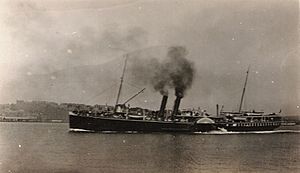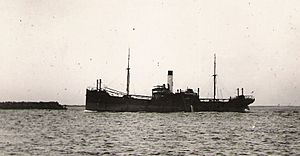History of Newcastle, New South Wales facts for kids
Imagine a place where people have lived for thousands of years! That's Newcastle, New South Wales, a city in Australia with a long and interesting past. Scientists have found tools and other items showing that Aboriginal people lived here at least 6,500 years ago.
The first European to visit this area was Lieutenant John Shortland in 1797. He was looking for escaped convicts. When he returned, he found a "very fine coal river," which he named after Governor John Hunter. This river was full of coal, which became Australia's first export!
Newcastle was once a tough place, used as a penal colony where dangerous convicts were sent to dig coal. But over time, it changed. By 1822, it was opened up for farming, and free settlers began to arrive.
Today, Newcastle is a busy port city. It's the world's largest port for exporting coal and one of Australia's oldest and busiest ports overall. The city has many old buildings, like the beautiful Christ Church Cathedral, Fort Scratchley, and the historic Customs House.
Contents
Ancient Times: Before Europeans Arrived
The land around Newcastle belongs to several Aboriginal groups, including the Awabakal, Worimi, and Darkinjung peoples. The Awabakal people called this area Mulubinba, named after a local fern.
Archaeologists have found amazing evidence that people lived here for at least 6,500 years. In 2009, they discovered over 5,500 Aboriginal tools and items at a site on Hunter Street. These items show that people lived and worked there during three different periods, dating back more than 6,700 years! This site is very important for understanding the history of the area.
In the 1820s, a missionary named Lancelot Threlkeld worked with a local Awabakal man named Biraban. Together, they recorded the Awabakal language, helping to preserve it. Since 1892, the Aboriginal people of Newcastle have been known as the Awabakal.
Europeans Arrive and Settle
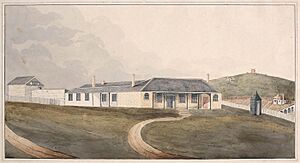
The first European to explore the Newcastle area was Lieutenant John Shortland in September 1797. He stumbled upon the area by accident while searching for convicts who had stolen a ship called HMS Cumberland.
On his way back, Lt. Shortland found a "very fine coal river," which he named after New South Wales' Governor, John Hunter. He reported back about the deep-water port and the huge amounts of coal. Soon after, coal from this area became the New South Wales colony's first export.
Newcastle quickly became known as a "hellhole." This was because it was where the most dangerous convicts were sent. They were forced to dig in the coal mines as a harsh punishment.
In 1801, a convict camp called King's Town was set up to mine coal and cut timber. The first coal shipment was sent to Sydney that same year. However, this first settlement closed less than a year later.
Another settlement was started in 1804. It was a place for convicts who caused trouble. It was first called Coal River, then Kingstown, and finally renamed Newcastle. The name came from England's famous coal port.
The new settlement, with convicts and soldiers, arrived at the Hunter River on March 27, 1804. Many of the convicts were rebels from the 1804 Castle Hill convict rebellion.
You can still see the link to Newcastle upon Tyne in some local place names. Towns like Jesmond, Hexham, Wickham, Wallsend, and Gateshead are named after places near the English city.
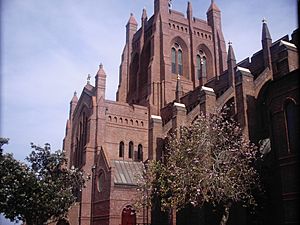
Between 1816 and 1818, under Captain James Wallis, conditions for convicts improved. A building boom began. Captain Wallis planned the town's streets, built the first church, and started work on the breakwater that connects Nobbys Head to the mainland today. In 1816, the first school in Newcastle was built.
Newcastle remained a penal settlement until 1822, when it was opened for farming. Military rule ended in 1823. The number of prisoners was reduced, and many were sent to Port Macquarie.
Early Ships and Trade
In the 1800s, the Newcastle & Hunter River Steamship Company started regular steamship services between Morpeth, Newcastle, and Sydney. The company had cargo ships and fast passenger ships, like PS Newcastle and PS Namoi. These ships made travel much easier and faster than long train journeys.
Because of the huge coal supply, small ships called "sixty-milers" (named for the distance between Newcastle and Sydney) sailed between Newcastle, Sydney, Brisbane, Melbourne, and Adelaide. They carried coal to power gas works, ships, and railways. These ships continued to operate until recently.
Newcastle During World War II
During World War II, Newcastle was a very important industrial city, helping Australia's war efforts.
In the early morning of June 8, 1942, a Japanese submarine called I-21 briefly fired shells at Newcastle. The shells hit areas like the dockyards, steel works, and the ocean baths. Luckily, no one was hurt, and the damage was small.
How Newcastle Grew: Its Economy
Coal Mining
Serious coal mining began in the 1830s, with mines close to the city and within 16 kilometres (10 miles). Many of Newcastle's main coal mines closed by the early 1960s. Larger coal mining operations then moved further inland to places like Kurri Kurri and Cessnock.
On December 10, 1831, the Australian Agricultural Company opened Australia's first railway. It was built to carry coal from near the Anglican Cathedral in Newcastle to the wharf for export.
Other Industries
In the 1850s, a large copper smelting factory was built near Merewether. Later, in the 1890s, another copper factory was built at Broadmeadow, and a zinc factory was built by Cockle Creek.
In 1885, the biggest soap factory in the Southern Hemisphere was built in Newcastle by Charles Upfold. His company, Sydney Soap and Candle Company, won many awards for its soap. After World War I, the factory was sold and closed in the mid-1930s.
Steel Production
In 1911, the company BHP chose Newcastle for its new steelworks because of the large amount of coal available. The land chosen was right on the harbour. In 1915, the BHP steelworks opened. For about 80 years, it was a huge part of Newcastle's heavy industry. It was the biggest employer in the region.
However, in 1999, the steelworks closed after 84 years. It had employed about 50,000 people during its time.
Major Events and Disasters
1989 Newcastle Earthquake
On December 28, 1989, Newcastle was hit by an earthquake that measured 5.6 on the Richter scale. This earthquake tragically killed 13 people and injured 160. Many important buildings were damaged or destroyed, including the George Hotel and parts of the Newcastle Workers' Club. The city took several years to recover from the damage.
June 2007 Storms
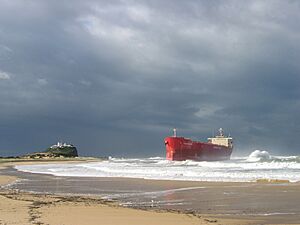
On June 8, 2007, the Hunter and Central Coast areas were hit by some of the worst storms in 30 years. This caused a lot of flooding and nine deaths. Thousands of homes were flooded, and many were destroyed.
During these storms, a large ship called the Pasha Bulker ran aground at Nobbys Beach. It became a famous local sight! After several attempts, the ship was finally refloated on July 2, 2007.
Maritime Accidents
The most tragic shipping accident in Newcastle in the 1900s happened on August 9, 1934. The ferry Bluebell crashed with a freighter called Waraneen and sank in the Hunter River. Three people died, and many were injured. It was later found that the ferry pilot was at fault.
Aviation Accidents
On August 16, 1966, a Royal Australian Air Force F-86 Sabre jet crashed into the suburb of The Junction. The pilot, Flying Officer Warren William Goddard, had engine trouble and tried to fly the plane out to sea. He ejected, but his parachute didn't open fully, and he died. Even though it was a busy area, no one on the ground was killed or injured by the plane wreckage. A memorial plaque was later put up for the pilot.
Newcastle Today
The Port of Newcastle is still very important for the economy of the Hunter Valley. It's the world's largest port for exporting coal. Over 3,000 ships pass through each year, handling huge amounts of cargo.
Newcastle used to have a big shipbuilding industry, but it has become much smaller since the 1970s. The era of heavy industry, like the steelworks, ended in 1999. Now, many factories are located outside the city.

Newcastle has one of Australia's oldest theatre districts. The Victoria Theatre on Perkins Street is the oldest theatre built specifically for performances in the country.
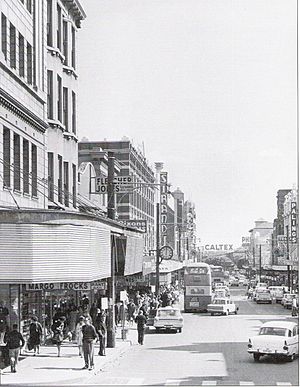
The old city centre, in Newcastle's eastern end, still has many historic buildings. The Christ Church Cathedral is a major landmark. Other notable buildings include Fort Scratchley, the Ocean Baths, the old Customs House, the 1920s City Hall, and the 1930s art deco University House. People from Newcastle are often called "Novocastrians."



